
Concept explainers
(a)
Interpretation:
The hybridization change of boron in the following reaction is to be determined.
Concept introduction:
The atomic orbital is the wave function that is used to find the probability to find an electron around the nucleus of an atom. It is the space around the nucleus of an atom where the electrons are supposed to be found.
Hybridization is the process of intermixing of atomic orbital of slightly different energies to form hybrid orbitals that have similar energy. These orbital have lower energy and more stability than the atomic orbital.
Hybridization of the central atom can be determined from the number of electron groups around the central atom in the Lewis structure of the molecule. Single bond, double bond, triple bond and lone pair all are considered as single electron group.
(a)
Answer to Problem 11.44P
The hybridization of boron changes from
Explanation of Solution
The Lewis structure of
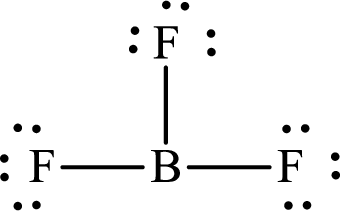
Boron forms three single bonds with three fluorine atoms so three hybrid orbitals are required and therefore the hybridization of boron in
The Lewis structure of
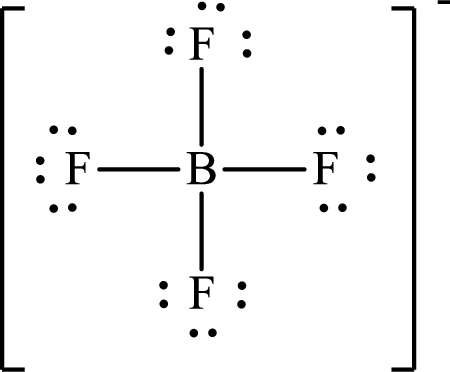
Boron forms four single bonds with four fluorine atoms so four hybrid orbitals are required and therefore the hybridization of boron in
The hybridization of boron changes from
Hybridization is determined from the number of electron groups around the central atom in the Lewis structure of the molecule.
(b)
Interpretation:
The hybridization change for phosphorus in the following reaction is to be determined.
Concept introduction:
The atomic orbital is the wave function that is used to find the probability to find an electron around the nucleus of an atom. It is the space around the nucleus of an atom where the electrons are supposed to be found.
Hybridization is the process of intermixing of atomic orbital of slightly different energies to form hybrid orbitals that have similar energy. These orbital have lower energy and more stability than the atomic orbital.
Hybridization of the central atom can be determined from the number of electron groups around the central atom in the Lewis structure of the molecule. Single bond, double bond, triple bond and lone pair all are considered as single electron group.
(b)
Answer to Problem 11.44P
The hybridization of phosphorus changes from
Explanation of Solution
The Lewis structure of
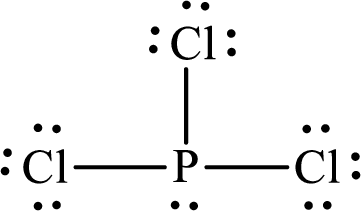
Phosphorus forms three single bonds with three chlorine atoms and has a lone pair on it so four hybrid orbitals are required and therefore the hybridization of phosphorus in
The Lewis structure of

Phosphorus forms five single bonds with five chlorine atoms so five hybrid orbitals are required and therefore the hybridization of phosphorus in
The hybridization of phosphorus changes from
Hybridization is determined from the number of electron groups around the central atom in the Lewis structure of the molecule.
(c)
Interpretation:
The hybridization change for carbon in the following reaction is to be determined.

Concept introduction:
The atomic orbital is the wave function that is used to find the probability to find an electron around the nucleus of an atom. It is the space around the nucleus of an atom where the electrons are supposed to be found.
Hybridization is the process of intermixing of atomic orbital of slightly different energies to form hybrid orbitals that have similar energy. These orbital have lower energy and more stability than the atomic orbital.
Hybridization of the central atom can be determined from the number of electron groups around the central atom in the Lewis structure of the molecule. Single bond, double bond, triple bond and lone pair all are considered as single electron group.
(c)
Answer to Problem 11.44P
The hybridization of carbon changes from
Explanation of Solution
The Lewis structure of acetylene is as follows:

Carbon forms one triple bond with other carbon atom and one single bond with hydrogen atom so two hybrid orbitals are required and therefore the hybridization of carbon in acetylene is
The Lewis structure of ethene is as follows:
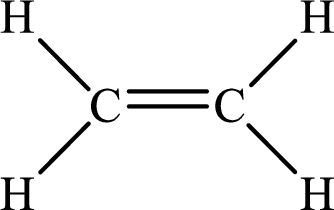
Carbon forms two single bonds with two hydrogen atoms and one double bond with another carbon atom so three hybrid orbitals are required and therefore the hybridization of carbon in ethene is
The hybridization of carbon changes from
Hybridization is determined from the number of electron groups around the central atom in the Lewis structure of the molecule.
(d)
Interpretation:
The hybridization change for silicon in the following reaction is to be determined.
Concept introduction:
The atomic orbital is the wave function that is used to find the probability to find an electron around the nucleus of an atom. It is the space around the nucleus of an atom where the electrons are supposed to be found.
Hybridization is the process of intermixing of atomic orbital of slightly different energies to form hybrid orbitals that have similar energy. These orbital have lower energy and more stability than the atomic orbital.
Hybridization of the central atom can be determined from the number of electron groups around the central atom in the Lewis structure of the molecule. Single bond, double bond, triple bond and lone pair all are considered as single electron group.
(d)
Answer to Problem 11.44P
The hybridization of silicon changes from
Explanation of Solution
The Lewis structure of
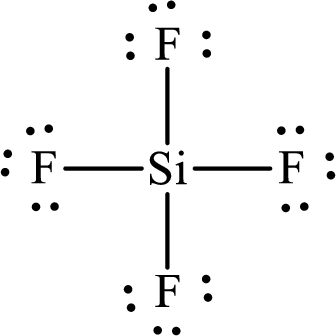
Silicon forms four single bonds with four fluorine atoms so four hybrid orbitals are required and therefore the hybridization of silicon in
The Lewis structure of
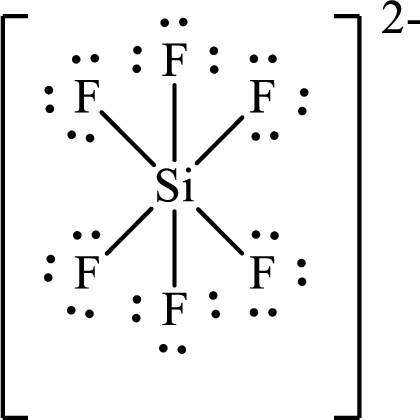
Silicon forms six single bonds with six fluorine atoms so six hybrid orbitals are required and therefore the hybridization of silicon in
The hybridization of silicon changes from
Hybridization is determined from the number of electron groups around the central atom in the Lewis structure of the molecule.
(e)
Interpretation:
The hybridization of sulphur in the following reaction is to be determined.
Concept introduction:
The atomic orbital is the wave function that is used to find the probability to find an electron around the nucleus of an atom. It is the space around the nucleus of an atom where the electrons are supposed to be found.
Hybridization is the process of intermixing of atomic orbital of slightly different energies to form hybrid orbitals that have similar energy. These orbital have lower energy and more stability than the atomic orbital.
Hybridization of the central atom can be determined from the number of electron groups around the central atom in the Lewis structure of the molecule. Single bond, double bond, triple bond and lone pair all are considered as single electron group.
(e)
Answer to Problem 11.44P
There is no change in the hybridization of sulphur.
Explanation of Solution
The Lewis structure of

Sulphur forms one single, one double bond with two oxygen atoms separately. It has a lone pair of electrons on it. So three hybrid orbitals are required and therefore the hybridization of sulphur in
The Lewis structure of
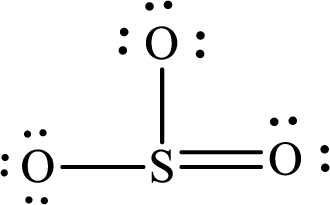
Sulphur forms two single bonds and one double bond with three oxygen atoms separately so three hybrid orbitals are required and therefore the hybridization of sulphur in
The hybridization of sulphur remains the same in going from
Hybridization is determined from the number of electron groups around the central atom in the Lewis structure of the molecule.
Want to see more full solutions like this?
Chapter 11 Solutions
CONNECT ACCESS CARD FOR CHEMISTRY: MOLECULAR NATURE OF MATTER AND CHANGE
- く Check the box under each a amino acid. If there are no a amino acids at all, check the "none of them" box under the table. Note for advanced students: don't assume every amino acid shown must be found in nature. COO H3N-C-H CH2 HO CH3 NH3 O CH3-CH CH2 OH Onone of them Explanation Check + H3N O 0. O OH + NH3 CH2 CH3-CH H2N C-COOH H O HIC + C=O H3N-C-O CH3- - CH CH2 OH Х 2025 McGraw Hill LLC. All Rights Reserved. Terms of Use | Privacy Center Accesarrow_forwardWrite the systematic name of each organic molecule: structure HO-C-CH2-CH3 O -OH CH3-CH2-CH2-CH2-CH2-C-OH CH3 CH3-CH-CH2-C-OH Explanation Check S namearrow_forwardtheres 2 productsarrow_forward
- Draw the major product of this solvolysis reaction. Ignore any inorganic byproducts. + CH3CH2OH Drawing Q Atoms, Bonds and Rings OCH2CH3 || OEt Charges OH 00-> | Undo Reset | Br Remove Done Drag To Pan +arrow_forwardDraw the major product of this SN1 reaction. Ignore any inorganic byproducts. CH3CO2Na CH3CO2H Drawing + Br Q Atoms, Bonds and Rings OAC Charges OH ОАс Na ဂ Br Undo Reset Remove Done Drag To Pan +arrow_forwardOrganic Functional Groups entifying positions labeled with Greek letters in acids and derivatives 1/5 ssible, replace an H atom on the a carbon of the molecule in the drawing area with a ce an H atom on the ẞ carbon with a hydroxyl group substituent. ne of the substituents can't be added for any reason, just don't add it. If neither substi er the drawing area. O H OH Oneither substituent can be added. Check D 1 Accessibility ado na witharrow_forward
- Differentiate between electrophilic and nucleophilic groups. Give examples.arrow_forwardAn aldehyde/ketone plus an alcohol gives a hemiacetal, and an excess of alcohol gives an acetal. The reaction is an equilibrium; in aldehydes, it's shifted to the right and in ketones, to the left. Explain.arrow_forwardDraw a Haworth projection or a common cyclic form of this monosaccharide: H- -OH H- OH H- -OH CH₂OHarrow_forward
- Answer the question in the first photoarrow_forwardGgggffg2258555426855 please don't use AI Calculate the positions at which the probability of a particle in a one-dimensional box is maximum if the particle is in the fifth energy level and in the eighth energy level.arrow_forwardExplain the concepts of hemiacetal and acetal.arrow_forward
 ChemistryChemistryISBN:9781305957404Author:Steven S. Zumdahl, Susan A. Zumdahl, Donald J. DeCostePublisher:Cengage Learning
ChemistryChemistryISBN:9781305957404Author:Steven S. Zumdahl, Susan A. Zumdahl, Donald J. DeCostePublisher:Cengage Learning ChemistryChemistryISBN:9781259911156Author:Raymond Chang Dr., Jason Overby ProfessorPublisher:McGraw-Hill Education
ChemistryChemistryISBN:9781259911156Author:Raymond Chang Dr., Jason Overby ProfessorPublisher:McGraw-Hill Education Principles of Instrumental AnalysisChemistryISBN:9781305577213Author:Douglas A. Skoog, F. James Holler, Stanley R. CrouchPublisher:Cengage Learning
Principles of Instrumental AnalysisChemistryISBN:9781305577213Author:Douglas A. Skoog, F. James Holler, Stanley R. CrouchPublisher:Cengage Learning Organic ChemistryChemistryISBN:9780078021558Author:Janice Gorzynski Smith Dr.Publisher:McGraw-Hill Education
Organic ChemistryChemistryISBN:9780078021558Author:Janice Gorzynski Smith Dr.Publisher:McGraw-Hill Education Chemistry: Principles and ReactionsChemistryISBN:9781305079373Author:William L. Masterton, Cecile N. HurleyPublisher:Cengage Learning
Chemistry: Principles and ReactionsChemistryISBN:9781305079373Author:William L. Masterton, Cecile N. HurleyPublisher:Cengage Learning Elementary Principles of Chemical Processes, Bind...ChemistryISBN:9781118431221Author:Richard M. Felder, Ronald W. Rousseau, Lisa G. BullardPublisher:WILEY
Elementary Principles of Chemical Processes, Bind...ChemistryISBN:9781118431221Author:Richard M. Felder, Ronald W. Rousseau, Lisa G. BullardPublisher:WILEY





